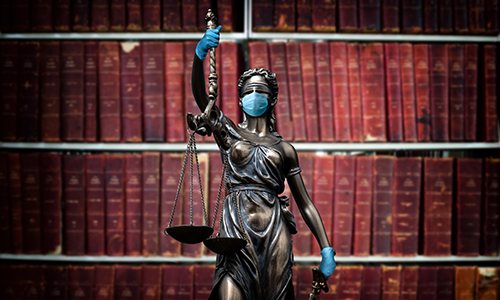Civil Justice after COVID-19
 Our mission at IAALS is forging innovative and practical solutions to problems within the American legal system. Like others, we have been forced to assess how our work and other aspects of our lives are impacted by the new reality resulting from COVID-19.
Our mission at IAALS is forging innovative and practical solutions to problems within the American legal system. Like others, we have been forced to assess how our work and other aspects of our lives are impacted by the new reality resulting from COVID-19.
The pandemic is highlighting shortcomings of our civil justice system that many people and businesses already knew. The system is too expensive, too complicated, and too slow. Low-income people, according to estimates by the Legal Services Corporation, receive no or inadequate legal help for 86 percent of their civil legal problems. Nearly 76 percent of cases in state courts involve at least one party who does not have a lawyer. Our nation’s legacy of racial discrimination, which tragically blights our criminal justice system, also creates inequities in civil justice. And with more than 40 million people losing their jobs and businesses closing daily, courts nationwide face a tsunami of debt collection cases, evictions, family disputes, domestic violence cases, and contractual disputes.
Our civil justice system was already in crisis in terms of meeting people’s needs, and the gap between this reality and our ideal of “justice for all” is growing larger.
Yet, even while the pandemic’s “unwelcome disruption” (borrowing a phrase from Michigan Chief Justice Bridget McCormack) increases the need for systemic improvements, it also offers a distinct opportunity to achieve them. Our legal system, for many reasons, generally has been slow to change—illustrated in part by the relatively limited implementation of online services by courts when compared to most other parts of our economy. But COVID-19 has forced our legal system to quickly adopt new ways of doing things. Nearly overnight, lawyers began working remotely and law schools shifted to distance learning. Across the country, many courts began requiring paperless filings and remote hearings, and some are trying bolder experiments like virtual grand juries, voir dire, and even jury trials. As Florida Circuit Court Judge Jennifer Bailey has observed, courts have made more innovations in the past month than in the preceding 20 years.
As we respond to the pandemic—and courts, lawyers, and legal educators have done so admirably and creatively in many ways—we should learn from these efforts and work to make long-term, fundamental changes. Doing so will be aided by recognizing some key propositions.
We can’t return to normal. It wasn’t good enough.
Let’s start by saying goodbye to “normal.” It may be comforting to think we can return to old ways of doing things in many aspects of our lives, but we cannot—and should not—do so in how we operate our civil justice system, provide legal services, and educate and regulate lawyers or other legal service providers. Instead of talking about a return to normal, or even a “new normal," we more usefully should focus on how we can sustain and expand on changes prompted by the pandemic to better achieve goals such as access, fairness, transparency, and greater innovation.
We must listen to those who use the system and learn from experience.
Decisions should be guided by empirical evidence, both as to the nature of problems and the impact of possible solutions. The US Justice Needs survey that IAALS is conducting with The Hague Institute for Innovation of Law (HiiL) will help us better understand the justice needs of individuals and businesses, including those created by the pandemic. Courts, lawyers, and organizations like the National Center for State Courts and the American Bar Association have commendably been surveying their constituents on emergency measures adopted in the face of COVID-19. And as Jeremy Fogel, Executive Director of the Berkeley Judicial Institute and former Director of the Federal Judicial Center, has noted, the changes adopted in the federal courts will provide ample data for assessing their effects, and perhaps help to overcome the traditional resistance in those courts to innovation.
Our evaluation of changes—ranging from text reminders of court events to virtual hearings to online dispute resolution—should also be informed by the views of those our legal system is meant to serve: the individuals and businesses who rely on it to protect their rights and resolve disputes. A great many of those who use our legal system are self-represented litigants who do not have a lawyer assisting them. User voices must be part of the conversation if long term changes are truly to promote justice.
We cannot forget that technology isn’t the only solution.
As courts implement remote proceedings and other changes to reduce public health risks or to save costs, we must be mindful of other concerns, particularly those related to procedural fairness. Just because a technology allows us to do some things more quickly, at remote distances, or for less cost does not necessarily mean we should do so. Other considerations may argue against doing so. For example, in-person proceedings in some circumstances may be constitutionally required or better respect individual dignity. Moreover, in assessing technology, we need to recognize the disparities within our society when it comes to access to computers and broadband Wi-Fi service.
We must continue to plan for the future.
The pandemic also underscores the value of embracing and planning for change, whether welcome or not. Courts that had already begun using e-filing, remote hearings, and improved case management processes have more easily adjusted to the pandemic. The same appears true for law schools that had experience with and well-considered plans for distance learning. And some courts—like those in Nebraska—had leaders with the foresight to include pandemics in their continuity of operations planning. The need to anticipate and adapt to such challenges and evolving technology will of course continue beyond our battle with COVID-19.
We must recognize the need for systemic changes, including in the legal profession.
Fundamental changes are needed across our legal system to better achieve justice, and we must recognize their interconnections. Using technology to better serve court users must also be accompanied by increasing the public’s access to legal information and legal services. Doing the latter requires us to rethink how we regulate lawyers and other legal service providers. We should better align legal education and the bar exam with the skills new lawyers need to serve their clients. Improving access, affordability, and innovation in legal education would increase the availability of legal services and the diversity of the bar, in turn promoting greater public confidence in courts and the legal system more broadly.
IAALS is working on many fronts to advance these goals. Those efforts include projects building on the Civil Justice Initiative and Family Justice Initiative to help courts to improve their processes in the face of the pandemic; our Building a Better Bar study to help determine the minimum competency that lawyers must possess; and Unlocking Legal Regulation in support of regulatory reforms in Utah, Arizona, and other jurisdictions. On the horizon are new projects aimed at identifying the views of court users on changes adopted due to the pandemic, a possible study of alternative bar admissions policies, and the development of discovery protocols for pandemic-related insurance disputes in court.
The pandemic has upended old ways of doing things in nearly every aspect of our lives, including our legal system. Let’s seize this opportunity to make fundamental changes we need to provide justice we can believe in.


